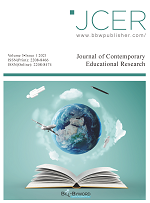Abstract
This article reports on a study of students’ reticence in English as a Foreign Language (EFL) classrooms in Panxi Vocational College in Sichuan Province of Mainland China. Forty-one students answered a 28-item questionnaire. The students’ reticence levels, general tendency of unwillingness-to-speak, and their learning behaviors were identified. Individual and social factors contributing to the reticence phenomenon in the vocational college’s EFL classrooms were also determined. The results suggested that culture have strong influences on Chinese vocational college students’ reticence. However, their habitual classroom behaviors that have been established for a long time should be taken into account in regard to their reticence.
References
Littlewood W, Liu NF, 1996, Hong Kong students and their English, Macmillan, Hong Kong.
Scollon R, Scollon S, 1995, Intercultural communication, Blackwell, Oxford.
Woodrow D, Sham S, 2001, Chinese pupils and their learning preferences in race ethnicity and education., 4(4): 377-94.
Cortazzi M, Jin L, 1996, Cultures of learning: language classroom in China, Cambridge University Press, Cambridge.
Cullen R, 1998, Teacher talk and the classroom context. ELT Journal, 53(3): 179-87.
Mehan H, 1979, Learning lessons: social organization in the classroom, Cambridge University Press, Cambridge.
Watson DI, 1999, ‘Loss of face’ in Australian classrooms. Teaching in Higher Education, 4(3): 355-62.
Liu M, 2006, Anxiety in Chinese EFL students at different proficiency levels. System, 34: 301-16.
Tsou W, 2005, Improving speaking skills through instruction in oral classroom participation. Foreign Language Annals, 38(1): 46-55.
Jackson J, 2003, Case-based learning and reticence in a bilingual context: perceptions of business students in Hong Kong. System, 31: 457-69.
Kennedy P, 2002, Learning cultures and learning styles: myth-understanding about adult (Hong Kong) Chinese learners. International Journal of Lifelong Education, 21(5): 430-45.
Tudor I, 1996, Language-centeredness as language education, Cambridge University Press, Cambridge.
Tsui ABM, 1996, Reticence and anxiety in second language learning, Cambridge University Press, Cambridge.
Cheng X, 2000, Asian students’ reticence revisited. System, 28: 435-46.
Xia SH, 2009, Are they ready to participate? East Asian student acquisition of verbal participation in American classrooms. Applied Linguistics, 17(2): 137-57.
Flowerdew J, Miller L, 1995, On the notion of culture in l2 lectures. TESOL Quarterly, 29(2): 345-73.
Liu M, Jackson J, 2009, Reticence in Chinese EFL students at varied proficiency levels. TESL Canada Journal, 26(2): 65-81.
Peng JE, 2007, Willingness to communicate in the Chinese EFL classroom: A cultural perspective. Perspectives and Standards, :250-69.
Xie XY, 2010, Why are students quiet? looking at the Chinese context and beyond. ELT Journal, 60(1): 10-20.
Zhang XQ, Head K, 2010, Dealing with learner reticence in the speaking class. ELT Journal, 64(1): 1-9.
